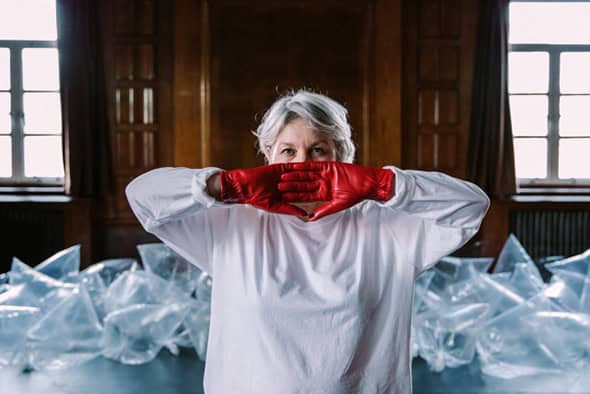The Breath Control Project, The Coronet Theatre
Posted: June 19th, 2019 | Author: Nicholas Minns | Filed under: Installation, Performance | Tags: Breath Choir, Carla Rees, Caroline Wright, Laura Wright, Liam Wright, Notes, Osmosis, The Breath Control Project | Comments Off on The Breath Control Project, The Coronet TheatreThe Breath Control Project, The Coronet Theatre, May 28

The following review is based on a dress rehearsal of The Breath Control Project that we were fortunate to be able to attend.
Life starts and ends with a breath. Each breath is a personal individual action while its metaphorical associations with life-force, vitality and spirit encompass the very significance and course of life itself. However, we are hardly ever aware of the rhythmic expansion and contraction of the chest that the inhalation and exhalation of air causes, unless we engage in activities like sport that require large amounts of oxygen, or in cases where breathing becomes difficult and we struggle for air. The Breath Control Project, an interactive installation and choral performance by visual and performance artist Caroline Wright at the Coronet Theatre, explores this most fundamental of bodily motions that supports and defines all other movements through its rhythmic cadences. While ‘control’ describes a conscious effort, the overall project more specifically engages the audience’s imagination with the invisible and yet tangible presence of the breath as a vital element of life. Like lungs, Wright’s project comprises two connected chambers within the theatre. Notes is a sound installation on the stage of the main auditorium and Osmosis is performed in the adjacent small theatre with members of the locally recruited Breath Choir.
For Notes a microphone stands centre stage facing an audience of transparent glass-blown tracheas suspended from the ceiling that oscillate in the light. Audience members are invited one at a time to stand in front of the microphone and produce a note using the full capacity of one breath. Each note is then collected in a sonic archive that digitally collates them as an orchestration that makes the breath palpable in this vocalized form. The work also has a social and scientific function: the data collected on each breath is correlated to current statistics on air pollution.
Osmosis explores the more tangible aspects of breath that include an experience by Liam Wright of the harrowing discovery of each breath, hampered by disease, becoming insufficient and strenuous. This arc of experience helps to define the intrinsic relationship between breath and wellbeing, and by translating it into motions and sounds Wright underlines what medical sources recommend as an appropriate breathing practice, placing at one point a metronome on the floor to which the performers walk, inhale, exhale — and cough — on the beat.
One of the memorable images is members of the Breath Choir, dressed in clinical white overalls and red rubber gloves, blowing each other a breath with their open hands as it were a gift or wish. It becomes like a game of tennis, with ever more strenuous attempts to serve and return the invisible substance with ever more ludic permutations. When the performers include members of the audience in the game we all enter into a circle of communal participation with our fragile environment and are asked to store a lungful of air in a transparent plastic bag. From this everyday action, the imagery extends to the harnessing of breath for playing a wind instrument (Carla Rees on flute) and singing, first with the Breath Choir and mezzo-soprano soloist Laura Wright (Caroline’s daughter), and then by Wright’s plangent rendering of Dido’s Lament from Henry Purcell’s Dido and Aeneas as she lies on a catafalque surrounded by our ritual offerings of surrogate lungs. Coming from the stillness, Wright’s voice sounds eerily miraculous, summoning up the sublime beauty that breath enables as well as the vulnerability of the present moment and of life itself.